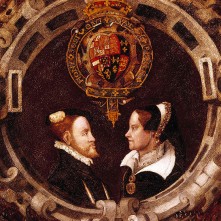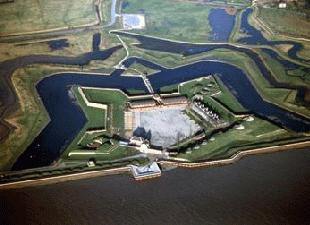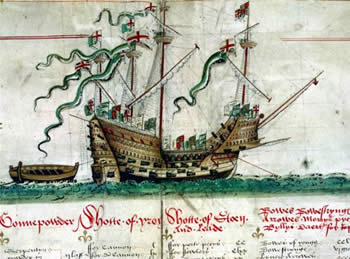25 July

Mary I and Philip of Spain
1538 – Death of John Barnewall, 3rd Baron Trimleston and Lord Chancellor of Ireland.
1539 – Death of Cardinal Lorenzo Campeggio, diplomat, Bishop of Salisbury, Cardinal-Protector and Papal Legate. Campeggio was buried in Santa Maria in Trastevere, but in 1571 his remains were moved to the church of Santi Marta e Bernardino, the church he had built in Bologna.
1554 - Mary I married Philip of Spain, son of Charles V, the Holy Roman Emperor, in Winchester Cathedral. Click here to read my article on this event over at The Anne Boleyn Files.
1556 – Baptism of George Peele, poet and playwright, in St James Garlickhythe, London. Peele's works included the pastoral comedy “The Arraignment of Paris”, “The Battle of Alcazar” and “The Love of King David and fair Bethsabe: with the Tragedie of Absalon”.
1577 – Death of Nicholas Barham, Sergeant-at-Law and Queen's Sergeant, at Oxford. He was a victim of the Black Assize (gaol fever), a fever which killed around 300 people associated with the trial of Roland Jenkes, a recusant bookseller.
1602 – Burial of Salomon Pavy, actor, at the church of St Mary Somerset, near Blackfriars Theatre. Pavy was just thirteen years-old, and is thought to have been abducted to serve as an actor in the Children of Paul's. He later joined the Children of the Queen's Revels at the Blackfriars Theatre and had parts in Ben Jonson's “Cynthia's Revels” and “The Poetaster”.
1603 – Coronation of James I at Westminster Abbey. As Westminster Abbey points out "he was the first Scottish King to be crowned sitting on the Stone of Scone (contained in the Coronation Chair) for over 300 years".
26 July
1538 – Death of George Talbot, 4th Earl of Shrewsbury and 4th Earl of Waterford, at South Wingfield Manor, Derbyshire. He was buried at St Peter's Church, Sheffield.
1588 - 4,000 men assembled at Tilbury Fort, the fort built on the Thames estuary in Essex by Elizabeth's father, Henry VIII, in anticipation of a Spanish attack.
1614 – Death of Henry Grey, 1st Baron Grey of Groby, at Bradgate Park. He was buried in the family chapel.
27 July
1534 – Murder of John Alen, Archbishop of Dublin, in Artane. Alen, his chaplains and servants, were murdered by the men of Thomas Fitzgerald, Baron Offaly, after their ship ran aground near Clontarf and they were taken prisoner. He was buried in a pauper's grave.
1550 – Baptism of George Whetstone, writer, at St Lawrence, Old Jewry. His works included “The Rocke of Regarde”, “The Honorable Reputation of a Soldier”, “Heptameron of Civill Discourses” and the two-part play “ Promos and Cassandra”, which was a source for Shakespeare's “Measure to Measure”.
1553 – Edward VI's former tutor and principal secretary, Sir John Cheke, was sent to the Tower for his part in putting Lady Jane Grey on the throne. He was released in spring 1554.
1578 – Death of Jane Lumley (née Fitzalan), Lady Lumley, translator, at Arundel Place in London. She was buried at St Clement Danes, the Strand, but later moved to a tomb in Cheam, Surrey. Jane is known as the first person to translate Euripides's “Iphigeneia at Aulis” into English, and she also translated various orations of Isocrates from Greek to Latin. Her work can be found in the British Library.
1593 – Execution of William Davies, Roman Catholic priest and martyr, at Beaumaris Castle on the Island of Anglesey. He was hanged, drawn and quartered. Davies was beatified in 1987 by Pope John Paul II.
1622 – Death of Thomas Knyvett, Baron Knyvett and Gentleman of the Bedchamber to Queen Elizabeth I and James I, at his home in King Street, Westminster. He was buried in Stanwell Church in Middlesex.
28 July
1488 – Death of Sir Edward Woodville, courtier and soldier, at the Battle of St Aubin du Cormier. Woodville was the brother of Elizabeth Woodville, consort of Edward IV.
1508 – Death of Robert Blackadder, Archbishop of Glasgow and administrator in the governments of James III and James IV. He died at sea, between Venice and Jaffa, while travelling on a pilgrimage to Jerusalem.
1540 - Thomas Cromwell, Earl of Essex, was executed by being beheaded on Tower Hill. Cromwell had been arrested on 10th June 1540 at a council meeting, and a bill of attainder was passed against him on 29th June 1540 for the crimes of corruption, heresy and treason.
1540 – Marriage of Henry VIII and Catherine Howard at Oatlands Palace. Henry's marriage to his fourth wife, Anne of Cleves, had been annulled just a few days before, so the wedding was a low key affair.
1540 – Execution of Walter Hungerford, Baron Hungerford of Heytesbury for treason. He was beheaded on Tower Hill and the charges included buggery and having dealings with witches.
1543 – Burnings of the Windsor Martyrs - Robert Testwood, Anthony Pearson and Henry Filmer – for heresy in Windsor, on waste-ground just north of the castle.
1563 – Ambrose Dudley, Earl of Warwick, surrendered Le Havre to the French after a siege which had lasted since 22nd May.
1585 – Death of Francis Russell, 2nd Earl of Bedford, Privy Councillor and diplomat, at his home in Russell Street, the Strand. He was buried at the chapel of Chenies, his seat in Buckinghamshire.
1588 – Five hell-burners were ordered to be sent amongst the galleons of the Spanish Armada at Calais. The high winds at Calais caused an inferno which resulted in complete chaos, and the Armada’s crescent formation was wrecked as galleons scattered in panic.
1591 – Execution of William Hacket, puritan and alleged prophet, at Cheapside Cross for treason after he had pierced a portrait of Elizabeth I “in the very place, representing her royall heart”, and defaced her coat of arms.
29 July
1504 – Death of Thomas Stanley, 1st Earl of Derby, husband of Lady Margaret Beaufort, and stepfather of Henry VII, at Lathom. He was buried at Burscough Priory. It is thought that it was Stanley who placed Richard III's crown on his stepson's head at Bosworth.
1509 – Birth of George Neville, son of Richard Neville, 2nd Baron Latimer, and his wife, Anne Stafford. Neville was Archdeacon of Carlisle and Rector of Salkeld, Spofforth and Morland.
1565 – Marriage of Mary, Queen of Scots, and Henry Stuart, Lord Darnley, at Holyrood Palace (the Palace of Holyroodhouse), Edinburgh.
1573 – Death of John Caius, scholar, Physician to Edward VI, Mary I and Elizabeth I, and founder of Gonville and Caius College, Cambridge, at his home near St Bartholomew's Hospital.
1588 - The Battle of Gravelines. The English fleet was victorious against the Spanish Armada. Click here to read more.
1589 – Hanging of Agnes Waterhouse, one of the Essex Witches, at Chelmsford in Essex.
1591 – Death of Edmund Coppinger, puritan and alleged prophet, after a 7-8 day hunger strike. Coppinger was an associate of William Hacket, who had been executed the day before.
30 July
1540 – Executions of Catholic martyrs Thomas Abell, Edward Powell and Richard Fetherston for refusing to acknowledge the royal supremacy. They were hanged, drawn and quartered at Smithfield. Click here for more information.
1540 – Burnings of religious reformers Robert Barnes, William Jerome and Thomas Garrard at Smithfield for heresy.
1550 – Death of Thomas Wriothesley, 1st Earl of Southampton, at Lincoln House in Holborn. He was buried in St Andrew's Church, Holborn, but then moved later to Titchfield. Wriothesley served Henry VIII as Lord Privy Seal and Lord Chancellor.
1553 - Princess Elizabeth left her new home, Somerset House, to ride to Wanstead and greet her half-sister, Mary, England’s new queen.
1563 – Birth of Robert Parry, writer and diarist, at Tywysog in Denbighshire, North Wales. His works included “Moderatus: the most Delectable and Famous Historie of the Black Knight”.
1570 – Burial of Sir William Godolphin, soldier, at Breage.
1588 - The wind changed and the remaining ships of the Spanish Armada were forced northwards and scattered. The wind became known as the “Protestant wind” because people believed that God had sent this wind to protect England from the Catholic Spanish Armada. Later, when it was obvious that the Spanish Armada had been defeated, medals were struck to celebrate and these medals were inscribed with “Flavit Jehovah et Dissipati Sunt“, meaning “Jehovah blew with His wind and they were scattered”. The wind certainly helped the English fleet.
31 July
1544 - The future Elizabeth I wrote her earliest surviving letter to her stepmother, Catherine Parr. It was written in Italian and in a beautiful italic hand. Click here to read more about it.
1549 – Death of Edmund Sheffield, 1st Baron Sheffield, in Norwich. It is said that he was killed by a butcher called Fulke, while serving in the royal army against the rebels of Kett's Rebellion. Apparently he stumbled into a ditch and then was killed by a blow from Fulke. Sheffield was buried in St Martin's at the Palace, Norwich.
1574 – Death of John Douglas, Archbishop of St Andrews and educational reformer, in St Andrews. He was buried in the public cemetery. It is said that he died in the pulpit.






Leave a Reply